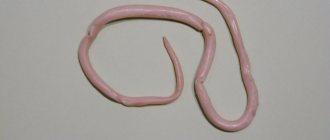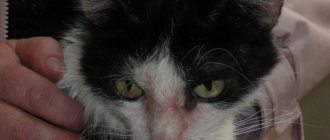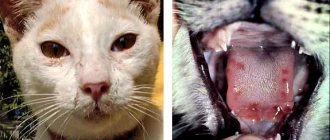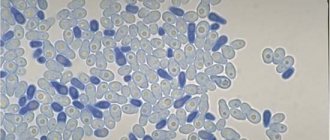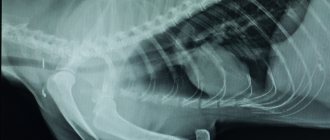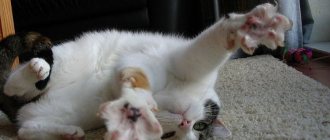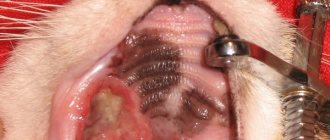What is distemper in cats
This is a highly contagious viral disease, which is also known as infectious parvovirus enteritis or panleukopenia. When infected, the number of all types of leukocytes in the bloodstream sharply decreases, the intestinal epithelium is affected, and a generalized infection affects the lymphatic system. Panleukopenia occurs more often in kittens - the still fragile body is more susceptible to the virus. The most dangerous time is spring and summer, when animals breed. Distemper in cats shows a high mortality rate, so it is important to start treatment in a timely manner - when the first signs appear.
Treatment
It is strictly forbidden to try to cure your pet on your own. This is fraught with serious complications and the transition of the disease to a more serious stage. Only a doctor can prescribe a competent course of treatment after a thorough examination and test results. Having established the exact form of distemper in a cat, therapy will be prescribed that will lead the animal to recovery. There is no single course of treatment or any miracle cure for the disease; the doctor builds therapy based on the data of a particular animal.
The basis of treatment is:
- Drugs that maintain water-salt balance at an optimal level;
- Vitamins and glucose to strengthen the immune system;
- Antibiotics and antivirals;
- Painkillers and antiemetics.
Average duration of treatment: 1-2 weeks. The duration depends on the health status of the particular pet and the severity of the disease. Under no circumstances should you stop therapy without a doctor’s examination, even if it seems that the virus has been defeated. The end of the course of treatment is possible after re-diagnosis at the veterinary clinic. Otherwise, an animal that is not completely cured may catch the virus again, and the disease will begin in a new circle.
Panleukopenia virus in animals
Feline distemper occurs as a result of damage to the animal's body by parvovirus, the name of which in Latin is Virus panleukopenia feline (FPV). The virus retains its virulence in the external environment for up to one year, while it does not decompose when heated for an hour to 60°C, does not respond to changes in acidity ranging from pH 3.0 to 9.0, is not afraid of frost, and can withstand the effects of pepsin and trypsin , diethyl ether and chloroform - thanks to such amazing resistance, the pathogen can easily infect more and more victims.
How is it transmitted?
The sources of this deadly disease are sick cats and virus carriers. Parvovirus is shed in stool (feces, urine) or saliva. There are several ways of contracting panleukopenia:
- During oral contact. The virus can enter the oral cavity along with saliva. More often this happens when drinking water or eating food infected with viral particles from a virus carrier or a sick animal.
- By airborne droplets. A healthy individual becomes ill with panleukopenia while in close proximity to a patient.
- By contact method. Infection occurs through personal belongings, clothing or shoes of the owner of a furry animal who has been in contact with a virus-carrying cat. In addition, parvovirus survives on litter trays, harnesses, bowls and toys for up to a year.
- In utero. The virus easily passes through the placental barrier and penetrates the fetus. Kittens infected at an early stage of pregnancy die (decompose inside, mummify) before birth or die 1-2 days after birth. Babies infected at a late stage often have congenital underdevelopment of the cerebellum.
- Transmissible method - when the causative agent of panleukopenia is carried by blood-sucking parasites - ticks, fleas, bedbugs.
Almost all representatives of the cat family can become infected with parvovirus: tigers, leopards, cheetahs. Among domestic animals, distemper is a widespread disease, to which unvaccinated kittens under one year of age and cats older than 6-8 years are more susceptible: young animals are predisposed to the disease due to undeveloped immunity, and older pets with age lose the ability to resist various viruses, because the immune properties of the body become weaker.
Pregnant cats and small kittens are also at risk of contracting panleukopenia. The chances of contracting plague increase in babies over two weeks of age. This is explained by the fact that the mother’s immunity weakens, and the baby’s own immune system is not enough to resist such a dangerous virus. If we consider breed predisposition, parvovirus is most dangerous for British representatives, Maine Coons, Siamese and Persian cats.
Is it dangerous for humans?
Panleukopenia is not dangerous to humans. They can only act as carriers of parvovirus on their outerwear, shoes and other things. Owners of several pets should be careful: if one cat has become infected with infectious enteritis, it must be isolated from a healthy cat and strictly quarantined. It is noteworthy that dogs are not afraid of the virus. Although they can get distemper, it can be caused by a completely different type of parvovirus.
How does a virus become infected?
As we said earlier in our article, the Felina Panleukopenia virus:
- very resistant to aggressive environmental factors;
- excreted in the feces of sick animals or recently cured animals.
Feces that may contain this pathogen are:
- animal saliva;
- cat urine;
- feces
One of the possible methods of infection is contact
Infection with distemper in carnivores is typical not only for representatives of small and medium-sized breeds of the cat family, but also for large animals, for example:
- Maine Coons;
- servals;
- caracals;
- other big cats that are so popular today.
So how does one become infected with a disease that, as it turns out, affects absolutely all cats? Here's how:
- the animal must come into direct contact with a substance containing the virus, that is, the biological fluid of another cat, in which case infection will occur by contact;
- provided that the infection is carried out through droplets of saliva, then it will occur by airborne droplets;
- the third route through which infection will occur is intrauterine, when a pregnant mother cat transmits this disease to her babies;
- through contact with parasites, when any blood-sucking insect or endoparasite attaches to your pet and bites it, at the same time transmitting a virus to it (mosquitoes, fleas, lice eaters);
- through a person, when the owner brings home on shoes or clothes particles of a substance containing inside the virus that causes canine distemper, thus even indoor animals can become infected with this dangerous disease.
Both purebred and outbred cats can get distemper, and the size of their body also does not matter
The greatest likelihood of contracting distemper occurs in those animals that become infected with the Felina panleukopenia virus by contact, that is, by sniffing, as a rule, feces defecated by a carrier of the virus.
The impact of the disease we are interested in primarily has an extremely negative effect on the animal’s blood, since when entering the body, the virus is primarily mistaken for:
- decrease in the number of leukocytes;
- the production of a toxin, which is then sent to the organs and destroys them.
First of all, the following are exposed to the negative effects of this disease:
- inner mucous surface of the intestine;
- animal heart muscle;
- lungs and respiratory tract;
- Bone marrow;
- lymphoid type tissues.
Damage to the above segments of the body leads to the animal developing primary disorders:
- dehydration;
- heart failure;
- disturbances in the functioning of the gastrointestinal tract, etc.
The older the animal, the more likely it is that it will survive this disease and also vice versa, the younger it is, the more likely it is that it will die.
Among all age groups, it is kittens that are practically unable to resist the disease; among a litter infected with the disease, usually no more than 10% of its members survive. In adults, mortality, despite the more significant strength of immunity, is also not at all small. So, of all the sick animals that survive:
- from 30%;
- up to 60%.
When infected with carnivore plague, the death of the animal occurs due to:
- severe dehydration of the body;
- heart muscle failure;
- the influence of secondary infections associated with the disease.
It is believed that animals aged approximately 2 to 6 years are least susceptible to the disease, since during this life period their immune system works best, while after six years it begins to weaken, and accordingly the cat’s protection is significantly reduced.
According to statistics, cats aged seven to eight years suffer from distemper as often as young animals.
The highest risk group is represented by kittens whose age ranges from several weeks to a year. By the way, if the disease is transmitted from the mother directly to the fetuses inside her womb, unfortunately, most often, the kittens die at the birth stage, or literally a couple of days or hours after birth.
The following phenomena also often occur in pregnant bitches with panleukopenia:
- miscarriages;
- mummification of fruits;
- resorption of embryos, etc.
There is no hope that your sick cat will give birth to healthy or at least viable kittens in the long term.
Forms of the disease
Distemper in cats develops subacutely, acutely or superacutely (with lightning speed). Find out more about these forms of the disease:
- Subacute form – typical for cats with strong immunity. The incubation period can last up to several weeks. Clinical signs of plague in the subacute form are not clearly expressed. Full recovery is possible provided that the animal's immune system is at a high level.
- Acute - in this case the incubation period is 1–2 days. Panleukopenia in this form mainly affects adult animals.
- The fulminant form of the disease is typical for young furry pets. Distemper in a kitten develops rapidly - literally within a few hours after the pathogen enters the body. The hyperacute form of the disease is clinically similar to the symptoms of rabies, while the signs often do not even have time to develop, and the animal dies in a very short time.
Distemper - what to do if there are two cats in the house
The risk that the second animal will get sick is quite high, so in this case special precautions are required:
- Isolate the sick cat and let it recover without contact with healthy animals.
- After contact with an infected animal, change clothes and wash your hands.
- It is urgent to vaccinate a healthy cat if this has not been done previously.
- Disinfect floors, dishes, toilet trays. A good sanitary solution is a diluted solution of bleach and water.
Plague is a most dangerous disease, but this is not a death sentence. You can and should fight for the life of a sick animal. With timely treatment, there is a chance of recovery, and good care increases them several times. After treatment, your pet will feel normal.
Health to your pets!
First signs
The virus manifests itself within 2–8 days from the onset of the disease. If the course of the disease is acute, the symptoms are:
- sudden refusal of food;
- oppression;
- increased body temperature, which rises to 40°C and above in 1-2 days;
- the cat behaves as if it is constantly thirsty, but at the same time drinks little;
- vomiting with dark yellow-green mucus appears;
- urine turns from dark yellow to light orange;
- the oral mucosa dries out;
- the blood vessels of the soft palate turn blue;
- During the examination, rhinitis, conjunctivitis, and swelling of the lining of the larynx are noted.
Symptoms
Parvovirus first affects the small intestine, then the bone marrow, the lymphatic system, and then occupies almost the entire body. Each form of the disease is characterized by certain symptoms. Fulminant is a course of panleukopenia that can infect kittens up to 2 weeks of age. This form of distemper leads to a sharp deterioration in health, manifested in refusal to suck milk, plaintive squeaking, and apathy.
Even if timely treatment is started, the baby will most likely die within 2 days. There are other symptoms of feline distemper, which occurs in a hyperacute form:
- lethargy;
- lack of response to his mother;
- matted, disheveled, unkempt, dull fur;
- reluctance to move, paralysis;
- trembling of limbs, convulsions;
- lack of appetite, thirst;
- vomiting blood or yellow or green foam.
In kittens aged 3 to 7 months, the nervous system suffers during the fulminant course of the disease. At the same time, to the above signs are added symptoms very similar to those that occur with rabies: the cat is frightened by any extraneous sounds, hides in distant secret corners, he begins to fear light, sunlight, he squeaks heart-rendingly when frightened, and nervous overexcitation is observed. After some time, loose stools, which have a specific foul odor, are added to the symptoms. In some cases, blood appears in the excrement.
The acute form of the disease occurs in adults. The symptoms differ from those characteristic of the fulminant form of plague and are as follows:
- interest in everything that is happening disappears, the cat constantly lies, does not react to the actions and voice of the owner;
- the temperature rises sharply to 41°C;
- heavy breathing appears;
- the animal refuses any food, even the most beloved;
- vomiting begins with yellow or green foam, in which after 36–48 hours particles of blood and mucus appear;
- rumbling in the stomach, watery diarrhea appears;
- red spots appear on the skin, which first fester and then disappear.
The high temperature does not last long, then drops to 37°C. Lower rates are harbingers of imminent death of the animal. A sick cat is very thirsty, but due to spasms of the larynx and pain in the abdominal cavity, she cannot. When the parvovirus reaches the cat's heart, it begins to breathe with its mouth open, and heart failure and tachycardia develop. When plague affects the respiratory organs (lungs, bronchi), the following symptoms are added:
- copious nasal discharge;
- redness of the eyes, watery eyes;
- hot, dry nose;
- wheezing in the chest when breathing, cough;
- frequent coughing;
- foci of inflammation on the epidermis filled with pus.
The subacute form is the most favorable form of the disease, in which almost all the main markers of plague can be traced, but their manifestations are insignificant. In this form, the disease occurs mainly in animals with stable immunity, in vaccinated animals and in individuals who are naturally in good health.
- Salad with Kirieshki: simple recipes with photos
- How to salt mackerel at home
- Birch sap at home
Treatment, feeding during the recovery period
The veterinary clinic should prescribe complex treatment, including etiotropic drugs, and also prescribe symptomatic drugs to relieve symptoms. A medicine, a sodium chloride solution, should be administered intravenously to reduce dehydration and relieve intoxication.
The course of treatment must include:
- Antibiotic therapy - to kill bacteria in the microflora. The immune system of an infected pet practically does not work and all the bacteria that enter the stomach are activated. To neutralize them, antibiotics must be used. The dose and combination of drugs must be selected by a doctor; as a rule, they are administered intravenously.
- Antibodies that are contained in serums and globulins. They are used to neutralize viruses. It should be borne in mind that they are effective only at the onset of the disease and as a preventive measure.
- Drugs that stimulate the immune system, such as interferon.
- Salts leave the body along with vomiting, so it should be stopped. Metoclopramide helps suppress vomiting; you can also use Cerucal.
- Distemper is accompanied by severe abdominal pain and fever. You can alleviate the animal's suffering by using painkillers and antipyretics, and you should also give antispasmodics.
- During this period, the animal also needs vitamins and iron supplements.
Feeding during this period of illness is difficult, since the sick pet is in an exhausted state and refuses food. There is no need to force people to take food and water. He should be fed parenterally (through a vein).
When the animal develops an appetite, you should take care of proper nutrition. His diet should consist of five feedings a day. Food should be pureed, warm and light. Fermented milk products and puree soups with boiled minced meat will be useful.
Feline distemper, treatment with vodka
Judging by reviews from forums about folk remedies, treating a furry friend with vodka at home also gives results and brings positive results.
Note! Treatment with vodka should be resorted to if the cat has been infected for only a couple of days and the disease has not yet had time to spread throughout the body.
If vodka really helps an animal, the result will be visible immediately after 24 hours.
The proportions are as follows: one tablespoon of vodka, mixed with egg yolk. This mixture must be fed to the animal 2 - 3 times a day, one spoon at a time.
Diagnostics
Only a veterinarian can determine whether an animal has distemper. To do this, at the slightest suspicion of infection, the cat must be taken to the clinic, taking with you a passport containing vaccination information. The doctor makes the diagnosis based on medical history, examination, laboratory and clinical tests. First of all, the veterinarian checks the stool for the presence of parvovirus particles - this test is performed using the polymerase chain reaction (PCR method). It should be noted that the PRC method will show a positive result only if the cat was vaccinated shortly before infection.
A characteristic sign of infection with panleukopenia is a sharp decrease in white blood cells. For this reason, a blood test is prescribed for a sick pet. The veterinarian carries out a differential diagnosis, because the signs of distemper in a cat are similar to the symptoms of pathologies such as poisoning, feline immunodeficiency, leukemia, pancreatitis or intestinal perforation.
??
Causes
Rhinotracheitis in cats: symptoms and treatment at home
Distemper in cats is an aggressive disease. The main reason for infection of a furry pet is weak immunity. The immune system of cats under 1 year of age undergoes a process of stabilization, during which time it is recommended to protect your pet from external influences. It is worth getting vaccinated and monitoring your vitamin intake to maintain your immune system. The risk of getting distemper increases as cats age. The aging age of cats starts at 6 years.
Treatment of distemper in cats
This disease is treated comprehensively, and this should only be done by a veterinarian. Therapy is of two types - etiotropic and symptomatic. Etiotropic – aimed at destroying the virus. The treatment uses the drug Vitafel, an immunoglobulin that fights the viruses of rhinotracheitis, panleukopenia and calicivirosis. Enterostat also helps to overcome the disease: the dose is 20 mg/kg 1 time/day for 7 days.
Excellent results can be seen after using the antiviral drug Fosprenil: the medicine is administered intramuscularly in doses of 0.5 ml for cats weighing 1–5 kg and 0.2 ml for cats less than 1 kg. The number of injections is affected by the duration of treatment:
- on days 1–2 – 4 injections/day.
- on days 3–10 – 3 injections/day;
- on days 11-13 – 2 injections/day;
- on days 14-15 – 1 injection/day.
Symptomatic therapy is aimed at minimizing the symptoms of distemper in cats. With this treatment, you need to take into account the following recommendations:
- First, correct the acid-base and water-electrolyte balance of the body, i.e. reduce dehydration and neutralize intoxication. To do this, you need to inject a solution of sodium chloride intravenously or subcutaneously.
- In the absence of vomiting, you can use Ringer's solution or Regidron orally. Each of these medications must be mixed with 5% glucose and a quarter teaspoon of soda. The daily volume of such a drink for a cat is calculated using the formula: 50 ml per 1 kg.
- Increase urine output in order to rid the body of toxic products. In this case, it is advisable to use herbal preparations: lingonberry, horsetail, bearberry, etc.
- It is mandatory to carry out antibiotic therapy to destroy the secondary bacterial microflora - the use of broad-spectrum drugs is indicated.
- Use vitamin supplements in combination with iron-containing supplements. Such medications must contain folic, ascorbic acid, vitamins A, B, C. Iron-containing ones are, for example, Ferrodextran (1–2 ml for an adult animal) and Ursoferran (0.3 ml/animal).
- It is necessary to stimulate the body as a whole and improve metabolism. Catozal is perfect for these purposes - the drug is administered daily for a week in the dosage specified in the instructions.
- Use antispasmodic medications to relieve spasms and reduce intestinal pain. Dibazol, No-shpa, etc. are suitable.
How to treat plague
Distemper is a disease that can be treated under certain conditions, but only if it is prescribed by a veterinarian and applied strictly according to the instructions of this specialist. To ensure that your pet’s illness is not complicated in any way, it is strictly forbidden to select a treatment for him on your own, since if the medicine is chosen incorrectly, the animal’s body will have to remove it as well, devoting strength to this, of which it already has little.
How to properly treat a cat for canine distemper?
It is also absolutely unacceptable to carry out therapy with folk remedies, for example, vodka, for which there are supposedly successful recipes for the use of panleukopenia in the treatment of panleukopenia.
Please pay attention to very important information: there is no cure for panleukopenia virus.
So how is it, you ask, that we were promised that you would talk about the treatment of distemper in cats?
That's right, we will indeed offer you effective therapy, which, nevertheless:
- is not able to have an impact directly on the virus that infected the animal;
- will help the body cope with the symptoms and negative consequences of the disease, while symptomatically affecting your cat’s condition.
Therapy will help your pet cope with the disease
In other words, the drugs that an animal undergoing treatment for panleukopenia will receive will have a targeted effect on the consequences of the disease, and not on the disease itself. All the rest of the work will be performed by a unique mechanism, all the secrets of which man has not yet been able to understand - immunity. In cats, it works on the same principle as in humans, destroying diseases in a way partially unknown to us. Our task in this case is to make his work as easy as possible.
So, in the treatment of the disease we are interested in, they use such drugs as:
- antibiotics;
- drugs that stimulate the immune system;
- enemas to remove toxins from the body;
- gastric lavage.
The duration of the course of medication is regulated exclusively by a veterinarian
Depending on the stage of development of the disease, its shape, the individual characteristics of the animal, its age and everything else, the course of treatment will last:
- from 7 days;
- up to 14-20 days.
You need to follow literally every single recommendation of the veterinarian, using the medicine according to the regimen he has developed:
- in a certain dosage;
- at specific hours;
- indicated course duration, etc.
It is very important to note how the cat’s condition changes. If treatment does not help, it is worth changing therapy.
You need to know a number of rules that will help you and your cat survive the disease as quickly and as safely as possible.
1. So, first of all, a sick animal must be placed for the duration of treatment in a room that:
- will be warm;
- frequently ventilated;
- illuminated by a lamp whose brightness can be adjusted from high to dim.
The cat should lie in a room that is frequently ventilated
2. While the room is being ventilated, the animal must be taken to another room so that it is not exposed to a draft. By the way, if healthy pets currently live in other premises, it is best to temporarily move them to another apartment.
3. As you remember, a secret will be regularly released from the cat's eyes, which you will have to:
- remove carefully with a cotton swab;
- wipe your eyes with a special solution, also applied to a cotton swab.
4. The room in which a sick cat lives must be disinfected using products specifically designed for this purpose.
5. Force feeding of cats is strictly prohibited. If he doesn't want to eat, it means he doesn't want to. Your task during his recovery is to prepare for him and periodically slip him:
- fresh chicken broth or broth from other meats;
- medium fat cottage cheese;
- curdled milk.
You should never force feed an animal, even if it hasn’t eaten for several days.
If the animal gradually begins to eat, after a couple of days you can try adding to its diet:
- meat, but not fatty;
- boiled fish, also not fatty, preferably sea fish.
It is advisable to heat the offered food on the stove or in the microwave and offer it to the cat five times a day in small quantities.
Please note: it is strictly forbidden to feed your pet during treatment and for two months after that:
- greens;
- vegetables;
- porridge.
Any coarse fiber during illness will do more harm than good, due to its ability to improve and stimulate intestinal motility
Diet
Distemper in cats is a serious disease, so after the animal is cured, it is important for the owner to take care of the appropriate nutrition for his pet. To do this you need to follow some recommendations:
- After the cat's appetite returns, the cat's menu should consist exclusively of light, slightly warm, pureed food.
- It is not recommended to feed your pet against his will - when he gets better, he will start eating on his own.
- Portions should be small, food should be given 5-6 times a day.
- It is allowed to feed low-fat broth, cottage cheese, kefir, and yogurt. After 3 days, you can gradually introduce a little boiled lean beef and fish fillet into the diet.
- Vegetables, fruits, grains, and any raw food are prohibited foods for cats that have just suffered from distemper - such foods can be given no earlier than after 2 months.
Disinfection
As already mentioned, plague is a very dangerous disease that is resistant to many external influences. To keep your recovering pet and other cats as safe as possible, you must follow the recommendations for disinfecting premises:
- Treat the room where the parvovirus-infected cat is located using a UV lamp and javel water (sodium hypochlorite solution).
- To disinfect rooms, cat beds, toys, bowls, use soda ash mixed in water (1 part soda/20 parts water) and formaldehyde gas.
- It is imperative to wet clean (up to several times a day) the room where a cat suffering from distemper lies.
- Do not forget about regular ventilation of the room in which parvovirus hovers. During this time, the pet must be moved to another room.
- Create a comfortable air temperature.
- Quickly remove feces and vomit from the animal.
- It is important to ensure that direct sunlight does not fall on a cat suffering from distemper.
- Constantly rinse your eyes from pus accumulating in the corners by soaking a cotton swab in the medicinal liquid.
Rules for caring for a cat during treatment
To prevent re-infection of the animal, it is necessary to promptly clean all surfaces and the cat itself from vomit and defecation products. Every two hours you need to ventilate the room where the sick animal is located. Disinfection of the cat's tray and bowls is mandatory. Once treatment has begun, the animal must be left alone. During this difficult period, your pet needs peace and sound sleep.
Vitamin injections will help maintain your pet's vitality. During the treatment period, it is recommended to follow a starvation diet, because the cat’s body has not yet gotten rid of harmful bacteria, and they will be absorbed into the blood along with food.
Transportation to a doctor's examination is carried out in a carrying bag.
Consequences
If you contact a veterinarian in a timely manner and provide assistance to a sick animal, the cat quickly recovers from distemper: the number of leukocytes in the blood is restored, it quickly gains weight, signs of rhinitis and conjunctivitis disappear, and body temperature drops to normal. After some time, the pet returns to its normal life.
It often happens that panleukopenia in cats does not go away without a trace. In this case, the furry pet will have unpleasant consequences for life. These include chronic disorders of the cardiovascular and respiratory systems, and nervous phenomena. After successful treatment, some animals are given special care and dietary ration for the rest of their lives.
Consequences after the disease
Successful recovery does not guarantee that the animal will not have health problems in the future. After an illness, there is a high probability of developing chronic inflammation of internal organs and systems. However, it’s up to the cat’s owner to do everything, because it’s possible to prevent the problem with three simple steps:
- Timely vaccination;
- Preventive examination at a veterinary clinic, especially if any symptoms are observed;
- Careful care for your pet: good nutrition and comfortable living conditions.
Prevention
Owners of furry pets should definitely know what methods exist to prevent such a terrible disease as distemper. To do this you need to know a few rules:
- If there are several cats in the house, the uninfected animal should be given to friends or placed in a nursery during the treatment of the sick one.
- If after three weeks of the incubation period the disease has not manifested itself in other pets, they must be vaccinated.
- It is advisable to vaccinate a cat at an early age - when the kitten is 2 months old, after which it needs to be revaccinated after 3 weeks.
- Adult cats from one year of age must be vaccinated annually, and pregnancy is a contraindication to vaccination.
Today there are vaccines that stimulate the production of intense immunity in animals, which lasts for a year. It is important to remember that only an absolutely healthy cat that has been treated for external parasites and helminths can be vaccinated. Vaccination is recommended with the following drugs:
- Quadricate;
- Multifel;
- Nobivac;
- Felocel.
Prevention of canine distemper
We hasten to assure you: the most effective way to treat the disease we are interested in is prevention, that is, in fact, simply preventing infection with the Felina Panleukopenia virus. Here are the most effective preventive measures.
1. The most effective remedy for this disease is timely vaccination. In this case, the cat will receive a specific serum that will bring its immunity to a full state of combat readiness. The validity period of such readiness is 12 months, that is, a full year from the moment immunity is formed.
Vaccination is the surest way to protect your cat from problems with distemper infection by any means.
It is recommended that this vaccine be administered to a cat at the age of 2 months, then again after three weeks, thus protecting the pet from the disease from a young age. As you can already understand, the vaccination procedure must be repeated every year, approximately on the same dates as the previous vaccination.
The most popular drugs used in veterinary clinics today will be the following:
- "Nobivak";
- "Felocel";
- "Multfel", etc.
Nobivac is one of the vaccines used to prevent panleukopenia in cats.
Please note the most important fact: it is strictly forbidden to vaccinate cats:
- having endo- or ectoparasites;
- at a young age, immediately before teeth change;
- pregnant women.
If the above contraindications are absent, you can safely use an effective medicine against this disease.
2. The second effective way to protect your pet from infection with distemper, provided that he lives in an apartment with an already sick animal, is to give it to friends or relatives for a while. Without the opportunity to come into contact with a sick cat, pets will not become infected with panleukopenia. Provided that after 3 weeks of living with family friends, the cat did not show signs of distemper, and its absence was confirmed by a veterinarian, it is necessary to vaccinate the animal according to all the rules, then, even if it returns to the house of a sick fellow, it will not catch the disease.
Limit animal contact for a time
Distemper in cats is a fatal disease, provided that the sick pet:
- still very small;
- has a weak immune system;
- awarded with secondary diseases;
- is of advanced age;
- will not receive proper treatment.
Your veterinarian will tell you how to cure this disease.
Unfortunately, to date, no specific treatment has been developed for this disease; all existing therapy is aimed at eliminating the negative consequences of the symptoms of the disease. The only 100% effective method that can protect your pet from this disease is timely regular vaccination. Don’t be lazy to carry it out on time, and you will enjoy your pet’s health for many years.
